Weapons of the Vietnam War
This article needs additional citations for verification. (October 2007) |

A wide variety of weapons were used by the different armies operating in the Vietnam War. Combatants included:
- the army of the Republic of South Viet Nam (ARVN) (South Vietnamese Army);
- the People’s Army of Vietnam (PAVN), commonly known as the North Vietnamese Army (NVA);
- the National Front for the Liberation of South Vietnam (NLF), better known as the Viet Cong (VC];
- all services of the U.S. military;
- the armies of South Korea, Australia, New Zealand, Thailand, and the Philippines; and
a variety of irregular troops. Nearly all allied forces including the ARVN and Australians were armed with U.S. weapons, some of which, such as the M1 Carbine, were substitute standard weapons dating from World War II. The NVA, although having inherited a miscellany of American, French, and Japanese weapons from World War II and the First Indochina War (aka French Indochina War), were largely armed and supplied by the People's Republic of China, the Soviet Union, and its Warsaw Pact allies. In addition, some weapons—notably anti-personnel explosives, the K-50M (a PPSh-41 copy), and “home-made” versions of the RPG-2—were manufactured in Vietnam. By 1969 the US Army had identified 40 rifle/carbine types, 22 machine gun types, 17 types of mortar, 20 recoilless rifle or rocket launcher types, 9 types of antitank weapons, and 14 anti-aircraft artillery weapons used by ground troops on all sides. Also in use, primarily by anti-communist forces, were the 24 types of armored vehicles and self propelled artillery, and 26 types of field artillery & rocket launchers.[1]
Weapons of the ARVN, US, South Korean, Australian, and New Zealand
Chemical weapons
In 1961 and 62 the Kennedy administration authorized the use of chemical weapons to destroy vegetation and food crops in South Vietnam. Between 1961 and 1967 the US Air Force sprayed 12 million US gallons of concentrated herbicides, mainly Agent Orange (a dioxin) over 6 million acres (24,000 km²) of foliage, trees and food crops, affecting an estimated 13% of South Vietnam's land. In the year 1965, 42% of the herbicide used was allocated to food crops. The herbicide use was also intended to drive civilians into RVN-controlled areas.[2]
In 1997, an article published by the Wall Street Journal reported that up to half a million children were born with dioxin related deformities, and that the birth defects in South Vietnam were fourfold those in the North. The use of Agent Orange may have been contrary to international rules of war at the time. It is also of note that the most likely victims of such an assault would be small children. A 1967 study by the Agronomy Section of the Japanese Science Council concluded that 3.8 million acres (15,000 km²) of land had been destroyed, killing 1000 civilians and 13,000 livestock.
Small arms
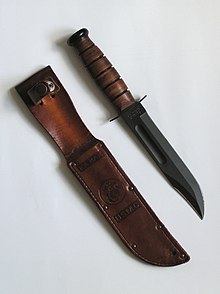
Knives/bayonets
- M6 bayonet
- M7 bayonet
- KA-BAR (USMC)
- KCB70 bayonet (Limited use with Stoner 63 rifle only)
Pistols & revolvers
- Browning High Power pistol - used by Australian and New Zealand forces. Also used on an unofficial basis by US Reconnaissance and Special Forces units.
- Smith & Wesson Mark 22 Mod.0 "Hush Puppy" - Suppressed pistol used by SEALs, among others
- Colt M1911A1 - It was the main side arm of the US Army and other countries except the ones in the Commonwealth.
- Colt Model 1903 Pocket Hammerless - Carried by General Officers, but it was replaced by the Colt Commander in the Mid-60s
- Colt Commander - Replaced the Colt M1903 pistol in the mid-60s
- Smith & Wesson Model 15 (USAF M15) - carried by USAF Security Police Units
- Smith & Wesson Model 12 - Given to helicopter pilots
- M1917 revolver - Used by the South Vietnamese and US forces during the beginning of the war alongside the Smith & Wesson Model 10
- High Standard HDM - It was replaced by the Smith & Wesson Model 39 as the main suppressed pistol because of its caliber
- Walther PPK with suppressor - It was used by Special Forces and spies
Infantry rifles
- L1A1 SLR - Used by Australian and New Zealand soldiers in Vietnam
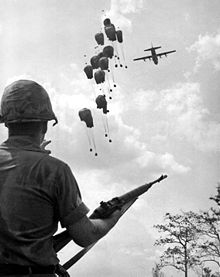
- M1 Garand - Was used by the Marine Corps during the early stages of the war. Also used by the South Vietnamese, South Koreans and Laotians
- M1 Carbine and M2 Carbine- Were widely used by the South Vietnamese Military, Police and Security Forces, the Viet Cong, and the US Military.
- M14 rifle It was issued to most troops from the early stages of the war until the early 1970s when it was used as a sniper rifle.
- XM16E1 and M16A1 - Early issue M16 had problems replaced by M16A1. After 1968 were issued to special forces and then infantry a year or two later.
- XM177E2 - Shortened version of the M16 rifle very popular with MACV-SOG units
- Heckler & Koch HK33 - It was used by Thai forces that were not armed by the United States. It was chambered for the same cartridge as the M16 assault rifle used by American troops.
- T223 - which is a copy of the Heckler & Koch HK33 Assault Rifle under license by Harrington & Richardson used in small numbers by Navy SEAL teams. Even though the empty H&R T223 was 0.9 pounds (0.41 kg) heavier than an empty M16A1, the weapon had a forty-round magazine available for it and this made it attractive to the SEALS.
- AR-15
Submachine guns
- Thompson submachine gun - It was used in small quantities by artillery and helicopter units. Even though it was replaced in the end of the Korean war after servicing in WW2 and the Vietnam war, it was still used by many American troops and South Vietnamese troops in the Vietnam war. The Viet Cong were armed with the Chinese copy.
- M3 Grease gun - The M3 "Grease gun" was issued to troops all over Vietnam was the main submachine gun, but many others were used such as the Thompson which was supposed to be replaced.
- Swedish K - It was used by Navy SEALs in the beginning of the war, but was later replaced by the Smith & Wesson M76 in the late 1960s. Many South Vietnamese soldiers were armed with this weapon and used it until the end of the war.
- Smith & Wesson M76 - A copy of the Swedish K, it replaced that gun as the main submachine gun of the Navy SEALs in 1967.
- Madsen M/50 - It was supplied by mercenaries from Denmark and a lot were bought by the United States for the South Vietnamese Army.
- MAC-10 It was supplied to many special forces troops in the mid point of the war. It armed many CIA agents in the field and was never captured by the Viet Cong.
- MP40 (CIDG)
- UZI (SOG recon teams) The Uzi submachine gun was supplied in from Israel and given to special forces troops in the field.
- Owen Gun (Australian submachine gun) It served the Australian Army through WWII, Korea, Malaya and now into the Vietnam War as the main submachine gun. It was later replaced by the F1 submachine gun that resembled it.
- F1 submachine gun (Australian, replaced Owen Gun)
- L2A1 a variant of the British Sterling used by the SASR for prisoner extraction also used with Silencer
- MP 5 Used by USMC Recon teams
Shotguns
The shotguns were used as an individual weapon during jungle patrol; infantry units were authorized a shotgun by TO & E (Table of Organization & Equipment). Shotguns were not general issue to all infantrymen, but were select issue, such as one per squad, etc.
- Winchester Model 1912 pump-action shotgun was used by the Marines during the early stages of the war.
- Ithaca 37 pump-action shotgun replaced every other shotgun in the field and armed the United States Marine Corps throughout the war.
- Remington 870 pump-action shotgun used by the Marines
- Special Operations Weapon a modification for a Remington 870 which made it fully automatic
- Remington 11-48 semi-automatic shotgun used by the Marines in small quantities
- Winchester Model 1897 used by the Marines during the early stages of the war, but was later replaced by the Ithaca 37
- Stevens Model 77E, pump-action shotgun used by Army and Marine forces in Southeast Asia. Almost 70,000 Model 77Es were procured by the military for use in SE Asia during the 1960s
Machine guns
- L2A1 AR - Full-automatic capable version of the L1A1 SLR used by ANZAC forces
- Stoner M63a Commando & Mark 23 Mod.0 - used by U.S. Navy SEALs and tested by Force Recon
- M60 machine gun GPMG (General Purpose Machine Gun) It was the main machine gun of the US army at the time and many of them were put on helicopters
- M1918A2 Browning Automatic Rifle - Issued to troops during the early stages of the war, but was replaced by the Stoner 63 and M60 machine guns.
- M1917 Browning machine gun - A .30cal heavy machine gun issued to some machine gunners in the South Vietnamese Army and also in limited use by the US Army.
- M1919 Browning machine gun - It was usually fit on platforms and boats, but was gradually replaced by the M60 machine gun.
- Browning M2HB .50cal Heavy Machine Gun
Grenades and mines

- Mark 2 Fragmentation Hand/Rifle Grenade
- M61 Fragmentation Hand Grenade
- WP M34 grenade White Phosphorus Hand Grenade is a smoke grenade that uses white phosphorus, which, when in contact with air ignites and creates white smoke. The white phosphorus was also a useful way to dislodge the Viet Cong from tunnels or other enclosed spaces as the burning white phosphorus absorbs oxygen, causing the victims to suffocate or suffer serious burns.
- M18 grenade Smoke Hand Grenade
- Claymore M18A1 - An anti-personnel mine
- M67 grenade
Grenade launchers
- M79 grenade launcher
- M203 grenade launcher - Used late in the war by special forces.
- China Lake Grenade Launcher - A pump-action grenade launcher used by U.S. Navy SEALs
- XM148 grenade launcher
- Mk.19 Automatic Grenade Launcher
Flamethrowers
- M2 flamethrower
- M9 flamethrower
Infantry support weapons

- M18 recoilless rifle 57 mm,
- M20 recoilless rifle 75 mm
- M67 recoilless rifle 90 mm
- M40 recoilless rifle 106 mm
- M19 Mortar 60 mm
- M29 Mortar 81 mm
- 4.2 inch mortar 107 mm commonly referred to as the "four deuce"
- M20 Super Bazooka used mainly by U.S. Marine Corps before introduction of M72 LAW
- M72 LAW Light Anti-Tank Weapon
- FIM-43 Redeye MANPADS (Man-Portable Air-Defence System)
Artillery

- 105 mm Howitzer M2A1
- 105 mm Howitzer M102
- M107 howitzer Self-propelled 175 mm howitzer
- M109 Self-propelled 155 mm howitzer
- M110 Self-propelled 8-inch howitzer
- 75mm Pack Howitzer M1
- L5 pack howitzer 105 mm pack howitzer used by Australia
Artillery ammunition types
- Beehive rounds
- White phosphorus (marking round) "Willy Peter"
- HE, general-purpose (High Explosive)
- Canister
Combat aircraft

- A-1 Skyraider ground attack aircraft
- A-37 Dragonfly ground attack aircraft
- F-5 Freedom Fighter fighter used in strike aircraft role
- A-4 Skyhawk carrier borne multirole strike aircraft
- A-6 Intruder carrier borne all weather multirole strike aircraft
- A-7 Corsair II carrier borne multirole strike aircraft
- AH-1 Cobra attack helicopter
- AC-47 Spooky gunship (four) with the 1st Air Cavalry Division
- AC-130 "Spectre" Gunship
- AC-119G "Shadow" Gunship
- AC-119K "Stinger" Gunship
- B-52 Stratofortress heavy bomber
- B-57 Canberra medium bombers - used by the U.S. Air Force
- Canberra B.20 Royal Australian Air Force medium bomber
- F-4 Phantom II carrier and land based fighter-bomber
- F-8 Crusader carrier borne fighter-bomber
- F-105 Thunderchief fighter-bomber
- F-100 Super Sabre fighter-bomber
- F-101 Voodoo (RF-101) fighter-bomber/reconnaissance plane
- F-102 Delta Dagger fighter
- F-104 Starfighter fighter
- F-111 Aardvark medium bomber
- OH-6 Cayuse Transport/ Observation helicopter
- OH-58 Kiowa Transport/ Observation helicopter
- OV-10 Bronco, light attack/observation aircraft
- UH-1 "Huey" gunship role (various models)
Support aircraft
- C-123 Provider tactical cargo aircraft
- C-130 Hercules tactical cargo aircraft
- C-141 Starlifter strategic cargo aircraft
- UH-1 Iroquois helicopters in several configurations
- CH-47 Chinook medium lift helicopter
- C-5 Galaxy strategic lift cargo aircraft
- C-7 Caribou tactical cargo aircraft - used by the U.S. Air Force and the Royal Australian Air Force
- CH-46 Sea Knight rescue helicopter
- H-2 Seasprite helicopter
- H-3 Sea King rescue and recovery helicopter
- UH-34 Seahorse Transport/Cargo helicopter
- CH-53 Sea Stallion medium lift helicopter
- CH-54 Skycrane heavy lift helicopter
- H-43 Huskie Transport/cargo helicopter
- O-1 Bird Dog, observation aircraft
- O-2 Skymaster, observation aircraft
- OV-1 Mohawk battlefield surveillance and light strike aircraft
Aircraft ordnance
- GBUs
- CBUs
- BLU-82 Daisy cutter
- Napalm
- Bomb, 250 lb, 500 lb, 750 lb, 1000 lb, HE (high explosive), general-purpose
- Rocket, aerial, HE (High Explosive), 2.75 inch
Aircraft weapons
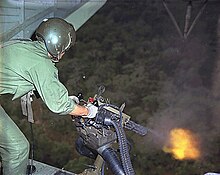
- M61 Vulcan, 20 mm (aircraft mount)
- Minigun, 7.62 mm (aircraft and helicopter mount)
- M197 Gatling gun, 20 mm
- M60 machine gun, 7.62mm (helicopter mount)
Vehicles
- M38A1 1/4 ton jeep
- Ford M151 MUTT 1/4 ton Military Utility Tactical Truck (jeep)
- Dodge M37, 3/4 ton truck
- Kaiser-Jeep M715 1¼ ton truck
- Truck, cargo/troops, 2½ ton (deuce and a half)
- Truck, cargo/troops, 5 ton
- M520 Goer Truck, Cargo, 8-ton, 4×4
- Land Rover short and long wheelbase - Australian and New Zealand forces.
- M135 troop/Cargo trucks, 2 1/2 ton
- M211 Cargo/troop truck, 2 1/2 ton
Combat vehicles
Tanks

- M41 Walker Bulldog light tank - Used by South Vietnamese Army ARVN
- M48 Patton medium tank - Used by the US Army, USMC, and ARVN forces
- M551 Sheridan airborne reconnaissance assault vehicle/light tank - Used by the US Army
- Centurion main battle tank - used by the Australian Army
Other armored vehicles
- M113 APC (Armored Personnel Carrier)
- M113 ACAV (Armored Cavalry Assault Vehicle)
- M8 Greyhound - Used by ARVN forces
- LVTP5 Landing craft
- M50 Ontos - Self-propelled 106 mm recoilless rifle carrier used by the USMC
- Cadillac Gage V-100 Commando
- Mark I PBRs (Patrol Boat River)
- LARC-LX
- BARC
- AMTRAC'S, amphibious tractors, US Marine Corps
- M114 Reconnaissance vehicle
- M42 Duster (M41 light tank based hull, with a twin 40 mm antiaircraft gun mounted on an open turret)
- LCVP Landing craft vehical personal
- LCM Landing craft mecanised
Gun trucks
Often, non-combat logistical vehicles were armored and adopted to carry several machine guns to be used for convoy escort duties
- Gun trucks, 2½ and 5 ton cargo trucks with quad .50 cal machine guns mounted in the back
- M3 halftracks with quad .50 cal machine guns in the back
- Jeeps with mounted M60 machine guns
- Land Rovers with single and twin M60 machine guns mounted used by Australian and NZ forces
Naval craft

- Monitor, heavily gunned riverine craft
- Swift Boat, (PCF) Patrol Craft Fast
- ASPB, Assault Support Patrol Boat, (known as Alpha boats)
- PBR (Patrol Boat River) - All-fiberglass boats propelled by twin water jets, used by the US Navy
- APA 27, USS George Clymer. Troop transport.
Weapons of the PAVN/NLF
NVA (North Vietnamese Army) and the Southern communist guerrillas NLF, or Viet Cong as they were commonly referred to during the war, largely used standard Warsaw Pact weapons. Weapons used by the North Vietnamese also included Chinese Communist variants, which were referred to as CHICOM's by the US military.
Artillery
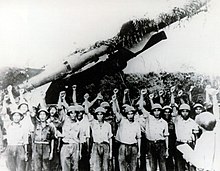
- ZPU-4 quad 14.5 mm anti-aircraft machine gun
- ZU-23 twin 23 mm anti-aircraft cannon
- M1939 37 mm anti-aircraft gun
- S-60 57 mm anti-aircraft gun
- 82 mm, 107 mm, and 120 mm mortars
- 122 mm Katyusha rockets
- 122 mm guns
Aircraft
- MiG-21 jet fighter
- MiG-19 jet fighter, used in limited numbers
- MiG-17 jet fighter
- MiG-15 jet fighter, used in limited numbers
- An-2 aircraft
- Mi-4 helicopter
- Mi-8 helicopter
Small arms
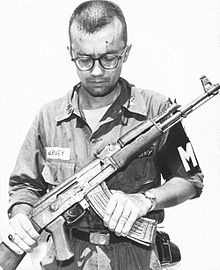
- AK-47 and AKM assault rifles (from the Soviet Union and Warsaw Pact countries)
- Type 56 assault rifle (from the People's Republic of China)
- SKS semi-automatic carbine, also known as Simonov
- Vz. 58 assault rifle
- SVD-63 semi-automatic marksman rifle, also known as the "Dragunov" sniper rifle
- Mosin-Nagant bolt-action rifles and carbines (from the Soviet Union, Warsaw Pact countries, and the People's Republic of China)
- Mauser Kar98k bolt-action rifle (many of the Mausers used by the VPA and the NLF were from rifles captured from the French during the First Indochina War and rifles provided to them by the Soviets as military aid)
- Sturmgewehr 44 assault rifle (captured by the Soviets during World War II and provided to the VPA and the NLF as military aid)
- Tokarev TT-33 handgun
- Makarov PM handgun
- Nagant M1895 revolver
- Mauser C96 handgun
- CZ 52 handgun
- Type 14 8 mm Nambu Pistol Pistol (Captured From The Japanese) Used By North Vietnamese officers
- K-50M submachine gun
- PPSh-41 submachine gun (both Soviet and Chinese versions)
- MAT-49 submachine gun
- Sa vz. 23 submachine gun
- RPD light machine gun
- Degtyarev DP light machine gun
- RPK light machine gun
- MG-34 light machine gun (captured by the Soviets during World War II and provided to the VPA and the NLF as military aid)
- MG-42 light machine gun (captured by the Soviets during World War II and provided to the VPA and the NLF as military aid)
- Uk vz. 59 general-purpose machine gun
- DShK heavy machine gun
- PM M1910 heavy machine gun
- MP40 submachine gun (captured by the Soviets during World War II and provided to the VPA and the NLF as military aid)
- PPS-43 submachine gun
- Arisaka rifles (Captured from Japanese)
- F1 grenade
- RG-42 grenade
- RGD-5 grenade
- Type 63 assault rifle
- PK machine gun
Flamethrowers
- LPO-50 Flamethrower (limited use)
Vehicles
- PT-76 amphibious tank
- BTR-50 APC
- BMP-1 APC
- ZSU-23-4 anti-aircraft self-propelled systems
- T-34/85 medium tank, used in limited numbers
- T-55 main battle tanks
- ZSU-57-2 anti-aircraft self-propelled system, fielded in limited numbers.
- BTR-60 APC
- Bicycles
Substitute standard weapons used by irregular forces
Small arms
- Arisaka bolt-action rifles
- M1 Garand rifle, semi-automatic
- M1 carbines, semi-automatic
- Springfield M1903 bolt-action rifles
- MAS-36 bolt-action rifles
- MAS-49 semi-automatic rifles
- MAT-49 submachine gun and local variants
- MP40 submachine guns
- PPS-43 submachine gun and local variants
- Swedish K submachine guns
- Mosin-Nagant bolt-action rifles and carbines
- Mauser Karabiner 98k bolt-action rifles
- Type 99 light machine gun Used occasionally by the Viet Cong
- Nambu semi-automatic pistol
- Colt M1911A1 Semi-Automatic Pistol
- M72 LAW
Hand combat weapons
- M6 bayonet U.S. Used on M-14
- M1 Bayonet U.S. and ARVN Used on M1 Garand, M1 Carbine, and M-14
- M7 Bayonet U.S. Use with the M-16
- Other types of knives, bayonets, and blades.
A wide variety of anti-personnel landmines and booby traps were used in the Vietnam war, including punji stakes.
Other ways of obtaining weapons
The Vietcong were not always able to be supplied by the PAVN. They sometimes took weapons from US soldiers after an attack or raided US or South Vietnamese weapon stockpiles. This increased the number of weapons available and gave balance against the US arsenal
Citations and notes
- ^ Department of Army Pamphlet 381-10, Weapons and Equipment Recognition Guide Southeast Asia, March 1969
- ^ Anatomy of a War by Gabriel Kolko, ISBN 1-56584-218-9 pages 144-145
- http://www.173rdairborne.com/weapons.htm
- http://www.vietnam-war.info/weapons/
- http://www.olive-drab.com/od_history_vietnam_weapons_equipment.php
- http://vietnamwarinfo.org/weapons-of-the-vietnam-war/
See also
- NLF and PAVN strategy, organization and structure
- NLF and PAVN logistics and equipment
- NLF and PAVN battle tactics
